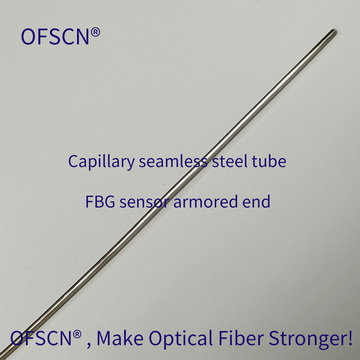This article uses a joke to explain the process of combustion. It analyzes the OFSCN® Capillary Seamless Steel Tube Series Fiber Bragg Grating Sensor (FBG sensor) produced by DCYS. The sensors include fiber bragg grating temperature sensors (FBG thermometers), fiber bragg grating strain sensors (FBG strain gauges), and fiber bragg grating stress sensors (FBG load cells and pressure sensors). They are non-combustible fiber bragg grating sensors. Partial physical diagrams of the full-metal encapsulated fiber grating sensors are provided.
Fiber bragg grating sensors are commonly used for temperature detection, especially in extreme temperature measurements in harsh environments, such as temperatures as low as -269 degrees Celsius and as high as nearly 1000 degrees Celsius.
Let's not worry about low temperatures because they don't cause combustion. However, when it comes to high-temperature detection, it is necessary to consider the material composition of the fiber optic grating sensors. Otherwise, if the sensors ignite during temperature measurement, it would become a joke.
 |
|
Figure 1 |
1. Necessary Conditions for Combustion of Fiber Optic Grating Sensors (FBG sensor)
Speaking of jokes, let's explain the process of combustion through a joke that only STEM students can understand:
Teacher X calls three students and asks them to fill the classroom as a test of their reaction ability. Student A closes the doors and windows of the classroom and tells the teacher that they have filled the classroom with air. Student B brings a bag of flour and easily scatters it everywhere, claiming that they have filled the classroom with flour. Student C takes out a lighter from their pocket, intending to fill the classroom with light. In the end, Teacher X and Students A, B, and C died.
 |
|
Figure 2 |
I believe many friends will smile knowingly or feel puzzled. Actually, this joke first explains the three conditions for combustion: the first condition is the combustible material (flour), the second condition is the oxidizer (air, or more precisely, a certain concentration of oxygen), and the third condition is the ignition temperature (ignition source). Additionally, it adds another condition for explosion: a sealed space. Therefore, this is a joke that only STEM students can understand.
 |
 |
|
Figure 3 |
Figure 4 |
2. Packaging Materials of the Non-Combustible OFSCN® Capillary Seamless Steel Tube Series Fiber Optic Grating Sensors (FBG sensor)
Now, let's move away from the joke and focus on the product. The main material of the OFSCN® Capillary Seamless Steel Tube Fiber Bragg Grating Sensor produced by DCYS is stainless steel. In the current atmospheric conditions on Earth, stainless steel seamless tubes are non-combustible materials.
If we want to be more demanding, let's take a look at the fiber optic connectors of OFSCN® Capillary Seamless Steel Tube Fiber Bragg Grating Temperature Sensors (as shown in Figure 3). The fiber optic connectors are also made of metal, and there is a ceramic material inside the connectors, which is also non-combustible. Therefore, we can confidently say that OFSCN® Capillary Seamless Steel Tube Fiber Optic Grating Temperature Sensors have the characteristic of being non-combustible, and they are safe to use for high-temperature measurements. They will not burn when used to measure high temperatures.
 |
| Figure 5 |
In addition to fiber bragg grating sensors, DCYS also manufactures various types of non-combustible OFSCN® or Capillary series distributed fiber optic sensors and high-temperature fiber optic jumpers. These products are also used in flammable high-temperature environments and require effective fiber optic protection (as shown in Figure 5).
Our philosophy is: "OFSCN®, make optical fiber stronger!"
